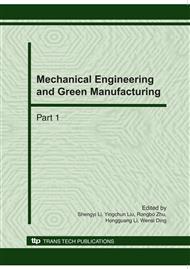[1]
Finnveden, G., Hauschild, M.Z., Ekvall, T., Guinée, J., Heijungs, R., Hellweg, S., Koehler, A., (.. ), Suh, S. Recent developments in life cycle assessment. (2009) Journal of Environmental Management, 91 (1), pp.1-21.
DOI: 10.1016/j.jenvman.2009.06.018
Google Scholar
[2]
Kaebernick, H., Kara, S., Sun, M. Sustainable product development and manufacturing by considering environmental requirements. (2003) Robotics and Computer-Integrated Manufacturing, 19 (6), pp.461-468.
DOI: 10.1016/s0736-5845(03)00056-5
Google Scholar
[3]
D. Millet, L. Bistagnino, C. Lanzavecchia, R. Camous, Tiiu Poldma. Does the potential of the use of LCA match the design team needs? Journal of Cleaner Production 15 (2007) 335-346.
DOI: 10.1016/j.jclepro.2005.07.016
Google Scholar
[4]
Handfield, R.B., Melnyk, S.A., Calantone, R.J., Curkovic, S. Integrating environmental concerns into the design process: The gap between theory and practice. (2001) IEEE Transactions on Engineering Management, 48 (2), pp.189-208.
DOI: 10.1109/17.922478
Google Scholar
[5]
Collado-Ruiz, D., Ostad-Ahmad-Ghorabi, H. Comparing LCA results out of competing products: developing reference ranges from a product family approach. Journal of Cleaner Production 18 (4), pp.355-364.
DOI: 10.1016/j.jclepro.2009.11.003
Google Scholar
[6]
Nielsen, P.H., Wenzel, H. Integration of environmental aspects in product development: A stepwise procedure based on quantitative life cycle assessment. (2002) Journal of Cleaner Production, 10 (3), pp.247-257.
DOI: 10.1016/s0959-6526(01)00038-5
Google Scholar
[7]
Alexis Gehin, Peggy Zwolinski, Daniel Brissaud. Integrated design of product lifecycles-The fridge case study. CIRP Journal of Manufacturing Science and Technology 1 (2009) 214-220.
DOI: 10.1016/j.cirpj.2009.05.002
Google Scholar
[8]
Carl Johan Rydh a, Mingbo Sun. Life cycle inventory data for materials grouped according to environmental and material properties. Journal of Cleaner Production 13 (2005) 1258-1268.
DOI: 10.1016/j.jclepro.2005.05.012
Google Scholar
[9]
Sousa, I., Wallace, D. Product classification to support approximate life cycle assessment of design concepts. Technological Forecasting and Social Change 73 (3), pp.228-249.
DOI: 10.1016/j.techfore.2004.03.007
Google Scholar
[10]
Database in Simapro 7. 18.
Google Scholar
[11]
Stuart Pugh, Don Clausing, Ron Andrade, (April 24, 1996). Creating Innovative Products Using Total Design. Addison Wesley Longman.
DOI: 10.1016/s0737-6782(97)89409-x
Google Scholar
[12]
S. Pugh, B. Hollins, (March 1990). Successful Product Design: What to Do and When. Butterworth-Heinemann.
Google Scholar
[13]
David G. Ullman. The Mechanical Design Process. McGraw-Hill Higher Education, Third edition. Chapter 4-5.
Google Scholar


